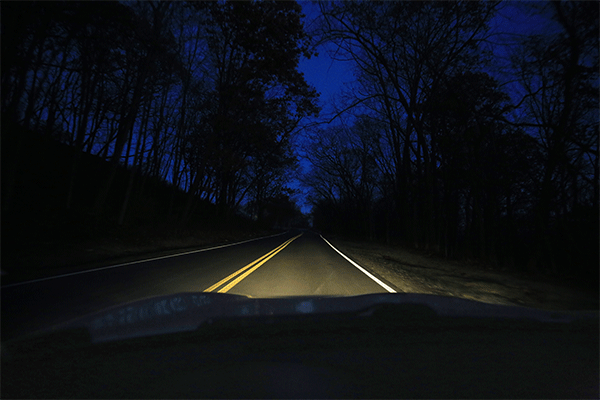Should You Upgrade Your Car’s Headlights?
Car headlights aren't one-size-fits-all -- and having the right ones is essential for helping you drive safely at night. (Sponsor: GEICO)

Driving at night can be more than challenging — it’s also one of the most dangerous times to be behind the wheel. Nearly half of all vehicle passenger fatalities in the United States occur at night, according to the National Highway Transportation Safety Administration (NHTSA); nighttime fatality rates for pedestrians and cyclists are even higher.
Headlights, of course, are crucial for safer driving in the dark. But three years ago, the Insurance Institute for Highway Safety evaluated 95 of the best available headlights on any given model and gave only two the highest rating. For the 2018 model year, 32 systems (out of 165) received the highest rating — but 75 were rated “marginal” or “poor.” The IIHS also found that even the same car model may come with different systems.
So how do you know what kind of car headlights are right for you? Greg Kopf, brand ambassador for CARiD, says three types of headlights are widely available, and each comes with pros and cons.
Types of Headlights
Halogen Headlights
The most basic system, halogen headlights bounce light off of a mirror behind the bulb, creating a flood-like beam of light — or, on some newer vehicles using a projector-style lens, a more direct beam.
- Upside: They’re cheap to replace — around $30 if a bulb burns out.
- Downside: The light itself, which is warm and yellowish, can be less illuminating than a bluer, brighter white light. Also, they last for only about 1,000 hours, so you may need to change them every couple of years.
HID Xenon
HID stands for the “high intensity discharge” needed to create an electrical arc in a bulb containing xenon gas, and each light has a built-in ballast to create the high voltage and current. HID xenon lights are often used only for low-beam headlights, with the high beam using a halogen system.
- Upside: The light is distributed via a projector lens, so the beam is more targeted and can shine farther. The light itself is bright white, which is closer to daylight and provides better illumination. Also, HID xenon systems last twice as long as halogen bulbs.
- Downside: Replacing these lighting systems can be pricey, running $100–$200 per bulb. Plus, the tiny units that control the system can fail, too, and they can cost as much as $600 each.
LED
LED, or “light emitting diode,” lighting is a system that’s been used in high-end automobiles for years. It’s now widely available in cars at many price points, though usually only as part of an upgrade package.
- Upside: LED lights emit bright, white light that’s like natural sunlight, in razor-sharp, focused beams — and do it using less energy than the other types of headlights. Plus, the lifespan for LED lighting is long — about 20,000 hours — so once you make the investment, it ought to last the lifetime of your car.
- Downside: LED systems are the most expensive of the three, adding as much as $3,000 to the price of a new car. They can also result in glare for drivers of oncoming cars, though that usually happens only when an aftermarket LED conversion kit is installed and the beam pattern isn’t properly adjusted.
How to Get the Headlights You Want
- In a new car: Ask the salesperson whether the headlights are halogen, HID xenon, or LED — or just look closely at the window sticker, which should tell you everything the car comes with. If the headlights are halogen and you want a different option, read the fine print. Often, says Kopf, upgrading the headlights requires buying an entire package of upgrades.
- In your current car: If you aren’t in the market for a new car but would like to upgrade your headlights, it’s pretty easy to do — and you’ll save a lot of money. LED conversion kits for halogen headlights run just $100–$300 for a set. If you don’t know how to install and adjust them yourself, it’s a safer bet to have a professional do the work.
Other Headlight Technologies to Look for
- Adaptive headlights: One of the most advanced lighting systems, adaptive headlights measure your steering angle, the back-and-forth movement of the car, and your speed. The system then directs the beam of light to align with these metrics.
- High-beam assist: With the assistance of a camera, this technology “reads” the road, automatically applying high beams on dark stretches. When it detects another car coming toward you, it switches back to low beams, so the driver of the oncoming vehicle isn’t blinded by the bright light.
- Adaptive driving beam (ADB): Keep an eye out for this technology, which actively modifies headlamp beams to continuously provide more illumination while sparing other drivers the distracting glare. In late 2018, NHTSA agreed to allow ADB to be introduced in the United States.
Now that you know more about the different headlight technologies available, make sure your car is covered with the right auto insurance. Get a fast, free quote on quality coverage today.
